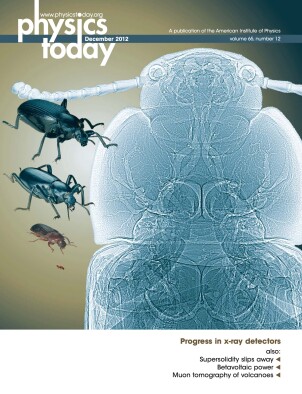NOAA consolidates its climate-modeling network
DOI: 10.1063/PT.3.1818
On 15 October, six years after it broke ground, the National Oceanic and Atmospheric Administration’s (NOAA’s) epicenter for weather modeling and operations officially opened the doors of its 25 000-square-meter, $76 million complex in College Park, Maryland. The NOAA Center for Weather and Climate Prediction was completed following two years of construction delays after the original developer went bankrupt.
The center, which will house more than 800 meteorologists, climate scientists, and other NOAA employees, has a stated mission to provide “environmental analysis, diagnostics and forecasts from the surface of the sun to the depths of the ocean floor.” That charge includes collecting data from ground-, ocean-, and space-based instruments; developing numerical models to predict weather events out to two weeks and air quality out to one day; projecting seasonal climate scenarios such as droughts and El Niño weather systems; and analyzing episodic events like volcanic eruptions and wildfires. The center’s meteorologists have been widely praised for their accurate prediction of the size, intensity, and path of Hurricane Sandy, the late-October storm that slammed several Caribbean islands and the US East Coast and left more than 100 dead and tens of billions of dollars in damages in its wake.
Weather Central, USA
The new facility is a flagship tenant of the University of Maryland’s nascent 186 000-square-meter research park, which already hosts UMD’s Earth System Science Interdisciplinary Center (ESSIC). The park (which is across the street from the offices of the American Institute of Physics, publisher of Physics Today) is also within 8 kilometers of NASA’s Goddard Space Flight Center and UMD’s College Park campus. The area is thus home to what UMD professor and ESSIC director Antonio Busalacchi claims is “the largest collection of Earth and environmental scientists anywhere in the world.”
In addition to having access to more external intellectual capital, says Busalacchi, NOAA’s operations will benefit from “the new sensors and observation equipment being developed at Goddard and the new simulations being developed at UMD.” The idea behind co-locating NOAA’s environmental modeling operations with UMD and NASA “was to accelerate the transition of research to operations,” says Louis Uccellini, director of the National Centers for Environmental Prediction. Five of the nine NCEP units are located in the new facility.
“The building is much better organized, and folks are a lot more accessible,” says Jacob Carley, who interned as an undergraduate in NCEP’s Environmental Modeling Center in 2007. He is now serving with the same group as a visiting PhD scientist, developing forecasts that will potentially be used by the wind energy industry. At the old offices, “the land surface modeling group had to be moved across the street for lack of space,” says Carley. “Now we’re all on the same floor.” NOAA spokeswoman Maureen O’Leary says the new center has allocated space for up to 40 visiting scientists—it now has 17—and its goal is to fill most of those spots within six months.
For scientists in the Air Resources Laboratory (ARL), also located in the new building, testing custom-made or modified commercial chemical monitors without leaving the building is a luxury. “At the old facility, there was no way for us to test our instruments because we didn’t have access to ambient air,” says lab director Steven Fine. Now the ARL occupies a portion of the top floor and can sample atmospheric chemicals, such as carbon and nitrogen oxides and mercury, through conduits built into the exterior walls; the lab’s location also provides easy access to the roof, which will double as an experimental base for testing atmospheric chemistry instrumentation.
The lab is developing collaborations with UMD faculty and staff who want to test their air-monitoring equipment at NOAA’s new center, says ARL scientist Winston Luke. Already, UMD atmospheric scientist Jeffrey Stehr and some of his students are preparing nitrogen oxide and mercury monitors for testing in the ARL. “The close proximity allows us to do some nice experiments on small-scale variability of atmospheric pollutants,” says Stehr.
Friendly competition
Access to NOAA and its scientists gives UMD’s students a leg up, says Stehr. The new center, he says, will likely be a popular destination for seniors in the university’s atmospheric and oceanic science department who need to complete their thesis projects. Katherine O’Brien, a junior at UMD, has already gotten a taste of the increased access: This past summer O’Brien worked alongside ESSIC and NOAA scientists who are modeling Earth’s surface energy budget. “It was a great experience, she says, and it “gave me a better understanding of what goes on behind the scenes” in climate forecasting.
Moving to a university campus and strengthening and establishing collaborations, says Busalacchi, could make NOAA much more competitive with the UK-based European Centre for Medium-Range Weather Forecasts, “arguably the world’s best weather forecasting operation.” That center, he says, has historically been more open than NOAA to visiting researchers.
“It’s a friendly competition between us and other weather centers around the world,” says NCEP’s Uccellini. “We want to have the best models in the world—and the National Academy of Sciences has recently set for us the goal of being ‘second to none’—but we also know we need to collaborate with each other.”

In preparation for his seven-day weather forecast, meteorologist David Roth examines several computer models generated by the Hydrometeorological Prediction Center, one of several groups housed in the NOAA Center for Weather and Climate Prediction.


A sloping roof to collect and recycle rainwater is one of several eco-friendly features of the new NOAA Center for Weather and Climate Prediction, located on the University of Maryland’s M Square Research Park.

